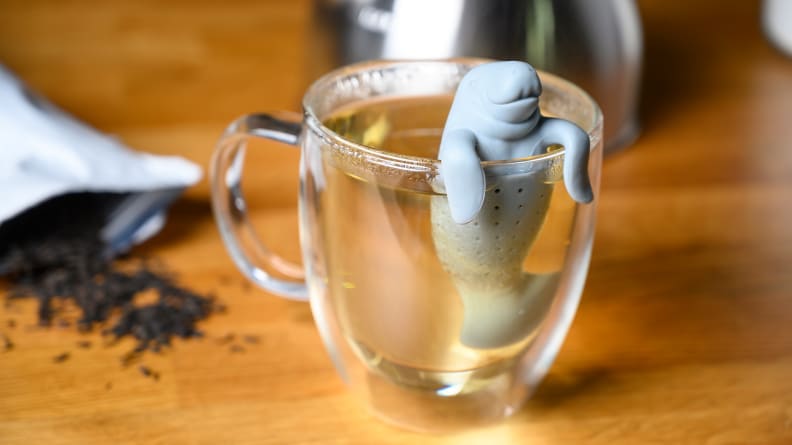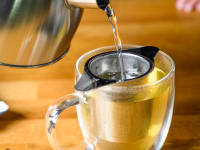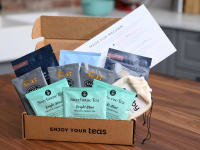Your tea bags may be toxic: Here’s how to brew instead
Steep your next cuppa with healthy confidence
 Credit:
Canva
Credit:
Canva
Products are chosen independently by our editors. Purchases made through our links may earn us a commission.
"Drink more tea," they said. "It's good for you," they said. And they aren't wrong—tea certainly has its benefits. But now there's news that tea bags may actually be bad for you. With everything else going on in the world over the past few years, it’s likely not something that’s occurred to you—especially in light of everyone telling us how good tea can be for our health.
Some teas are full of antioxidants, and most contain less caffeine than a cup of coffee. But according to a study by the American Chemical Society, some teas can contain hidden dangers, particularly if you're brewing your cuppa using plastic tea bags.
Should I be worried about toxic chemicals in tea bags?
Honestly, you should be worried about toxic chemicals in anything you eat, drink, or wear.
When it comes to tea, steering clear of toxins can be easier said than done. Researchers at McGill University tested four popular brands of tea sold at grocery stores and found that a single plastic tea bag can release 11.6 billion microplastic particles and 3.1 billion nanoplastic particles into the water. If it makes you feel any better (it shouldn’t) the same sort of microplastics are found in other common foods and beverages, but the McGill study revealed that the levels released by the tea bags were thousands of times higher than other products.
What makes tea bags toxic?
If there was only one factor that amounted to a toxic tea bag, we could likely remove it, and that'd be that. Unfortunately, as with most things concerning our health, it's a little more complicated. Which toxic materials find their way into your tea bags depends on which primary material is used to make the bag. So, let’s break it down by the type of tea bag you’re dunking.
Plastic tea bags and nylon tea bags
Tea bags made using plastic can shed microplastics (tiny pieces of plastic) and nanoplastics (really tiny pieces of plastic) into the water as your tea steeps. These microplastic particles can find their way into your body. No one can say definitively what these plastics do to our bodies–we’re simply not far enough into the research. However, there is evidence that once microplastics and nanoplastics are inside of us, they can cause inflammation, tummy troubles, cancers, cardiovascular issues, damage to our internal organs, and even mess with our DNA.
While the research can’t give us a conclusive answer yet, given what we know so far, staying the heck away from plastic and nylon tea bags is likely a good idea.
Paper tea bags
The majority of the tea bags used in the world today are made using filter paper: It's the same stuff that coffee lovers use in the hopper of their favorite drip coffee maker.
Filter paper is made using several materials that contain cellulose: wood pulp, cotton, and even the fiber from banana tree leaves. These materials are safe enough: You could eat a bowl of the stuff and be fine. It's what they do to make tea bags out of filter paper that causes the finished product to be toxic:
- Processing: The fibers used to make paper tea bags are pretty fragile, especially since the paper needs to be porous enough that liquid can easily seep through it. To artificially strengthen the bags, a chemical called epichlorohydrin is sometimes added. Dow Chemicals, who makes a lot of epichlorohydrin, says that it has been known to cause cancer in laboratory animals.
- Bleaching: Many brands bleach their paper tea bags using chlorine dioxide, which dissolves in water. The chemical is corrosive—although you'd need to drink a lot of tea from chlorine dioxide-blacked bags before you’d notice any effects from it.
- Fasteners: After paper tea bags are filled with, well, tea, they're sealed up to prevent the dry tea from escaping the bag. Most often, this is done with either a heat-sealing agent or a staple. The glue used to heat-seal tea bags often includes polypropylene as an ingredient. Staples, which are often used to seal one end of the tea bag or to attach the string used to dunk the bag in your cup of hot water, can shed rust or chemicals used to coat the metal.
Will removing the tea from the tea bag make drinking it safe?
Nope! The tea leaves will have already been exposed to the chemicals from the bags. So, while the dose of those toxic chemicals won’t be as high, as wouldn’t be heating the bag in boiling water, there’s still a trace amount present. Over time, those trace chemicals have the potential to do you harm.
How to know if your tea bags are safe
The easiest way to know that your tea bags are safe is to avoid plastic and paper tea bags. Doing so eliminates the microplastics and nanoplastics that come from using the plastic ones, as well as your exposure to bleaching agents and carcinogens from steeping your tea in paper ones.
We get it: Tea bags are convenient. If you insist on using them, opt for ones that are completely biodegradable, plastic-free, or labeled as organic. Looking for tea bags that claim to be "free of epichlorohydrin" in their marketing is a good idea as well.
Are any tea bags safe to use?
Despite the ubiquity of toxins in tea bags, there are many brands out there that care about their customers and the environment. Twinings, Tazo, Barry’s (our personal favorite), and Red Rose all come in tea bags that are safe to make a cuppa with.

Started in London by Tom Twining, these are your classic British tea bags.

Tazo specializes in bolder, unique tea blends; each bag is fully compostable.

This strong and hearty Irish tea demonstrates the fortitude and commitment of its founders over 100 years ago.

This popular American brand of tea bags can be found on supermarket shelves everywhere.
What's a better alternative to tea bags?

Tea diffusers, like the Manatea, are a safe, efficient way to brew loose-leaf tea.
The safest alternative to tea bags is to buy tea with no bag at all. Loose-leaf teas are not only a chemical-free option, but they tend to be fresher and more flavorful than bagged teas, and you can use a tea infuser to brew it.
What is a tea infuser?
Often made using stainless-steel or food-grade silicone, a tea infuser holds loose-leaf tea, keeping it from drifting around the hot water in your mug or teapot. They’re reusable, machine washable, and can be used to brew a little, or a lot, of tea.
One of the great things about an infuser is that it gives you greater control over the qualities of your tea. It’s easy to brew a strong cup of tea with an infuser: just stuff more loose tea into it than you normally would.
You can also create personal tea blends by mixing multiple styles of tea leaves into the infuser. Chaos reigns in your cup when you own a tea infuser.


Fred Manatea infuser's design is functional and cute. It's easy to clean, but leaves can get stuck inside.
Read Our Review

Yoassi's stainless-steel infuser fits a large cup. It steeps quickly and evenly, but watch your fingers because the infuser does get hot.
Read Our ReviewBrewing methods: How to brew the best cup of tea with an infuser
Using a tea infuser is different than a tea bag. Because loose-leaf tea can be stronger than bags, remember to remove your infuser after a few minutes to keep it from becoming too strong and bitter.
For ideal brewing times (and temperatures), check the tea's brewing instructions first.
As for the infusers themselves, take care of them properly so that they last longer and brew better. Make sure to keep the holes clear of stuck leaves, and let them dry completely before storing them away.
Our favorite loose-leaf teas
Reviewed’s staff is full of tea drinkers. When we asked about some of their favorite loose-leaf teas, the answers were fast and furious: Palais des Thés, Kusmi, Fortnum & Mason, and Art of Tea.

Straight from Normandy, France, Kusmi loose-leaf teas are top quality.

The epitome of London tea time is exclusively sold at Williams-Sonoma on this side of the pond.

This mail-order tea retailer has a wide selection that you can have delivered through orders or subscription.
Our Expert
Séamus Bellamy is an enthusiastic tea drinker who’s sat with a hot cuppa scald through many a seisiún, on Canada’s east coast and overseas. He takes a lot of comfort from knowing that, even when life goes sideways, there’ll always be a mug of tea to sort it out over.
Resources
- Some Plastic With your Tea?, McGill University
- Scientists Warn of Harmful Release From Tea Bags, Newsweek
- Potential Health Impact of Microplastics: A Review of Environmental Distribution, Human Exposure, and Toxic Effects, ACS Publications
- Did You Know Teabags Contain Toxic Material?, Golden Moon Tea


